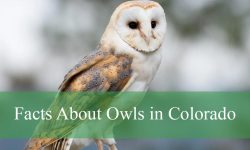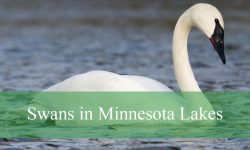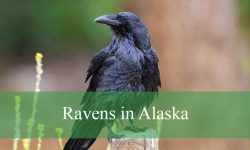Georgia boasts a diverse ecosystem that supports a wide variety of lizard species. From dense forests to rocky terrains, these reptiles showcase an impressive range of shapes and colors across the state.
This article highlights 20 of the most common lizards found in Georgia, complete with clear photos for easy identification. You’ll learn about their key features, habitats, and interesting facts about each species.
For nature lovers, researchers, or anyone curious about local wildlife, this guide provides valuable insights and vivid details about Georgia’s native lizards.
Common Lizards Found in Georgia
Eastern Fence Lizard (Sceloporus undulatus)
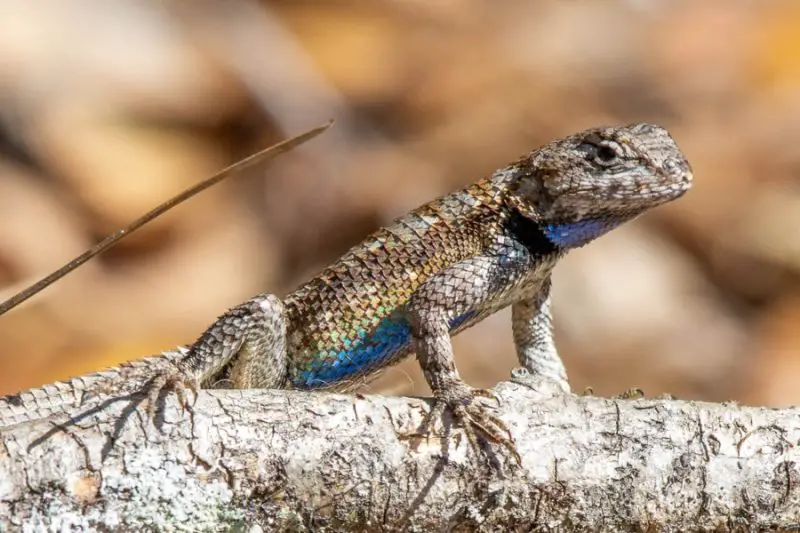
The Eastern Fence Lizard is a medium-sized, robust lizard native to the eastern United States, including Georgia. It measures about 5 to 7.5 inches in total length and features a rough, spiny appearance with a pattern of wavy black lines on its back and sides. Males are distinguished by bright blue patches on their throats and bellies, used to attract females and deter rivals.
These lizards are primarily ground dwellers but are frequently seen basking on fences, logs, and rocks. They feed on a variety of insects, such as ants, beetles, and spiders. Their behavior includes quick bursts of movement and tail waving to communicate or distract predators.
A fun fact about the Eastern Fence Lizard is its ability to survive in a variety of habitats, from dry pine forests to suburban areas. Its spiny scales provide good camouflage and protection, helping it avoid predation in Georgia’s diverse environments.
Florida Scrub Lizard (Sceloporus woodi)
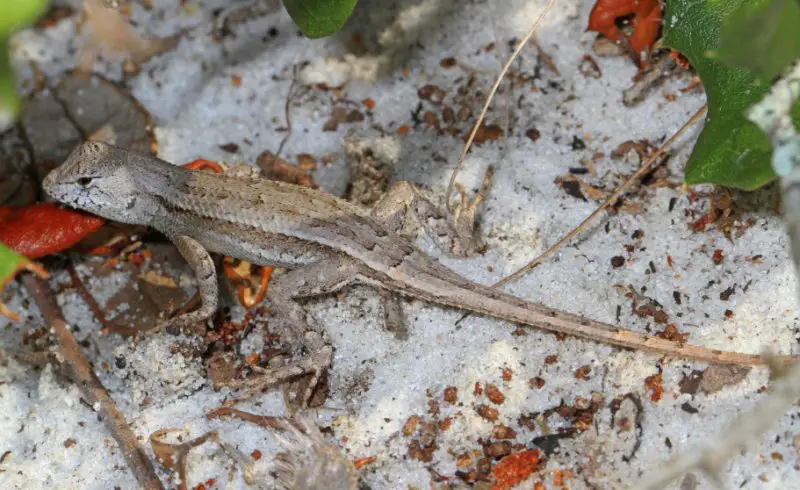
The Florida Scrub Lizard is a smaller, secretive species found primarily in scrub habitats but also recorded in southern Georgia’s sandy environments. It grows up to 5 inches long and has a grayish to brownish coloration with subtle dark markings. Males show blue patches on their throat and belly, although less vividly than other Sceloporus species.
This lizard prefers dry, sandy habitats with sparse vegetation and is an expert at camouflage. It feeds mostly on small insects and arthropods, foraging among leaf litter and low shrubs. It is less arboreal than some other lizards and relies on quick bursts of speed to evade threats.
A unique fact about the Florida Scrub Lizard is its strong habitat specificity; it is considered a habitat specialist and is sensitive to environmental changes, making it an indicator species for the health of scrub ecosystems near Georgia’s southern border.
Texas Spiny Lizard (Sceloporus olivaceus)
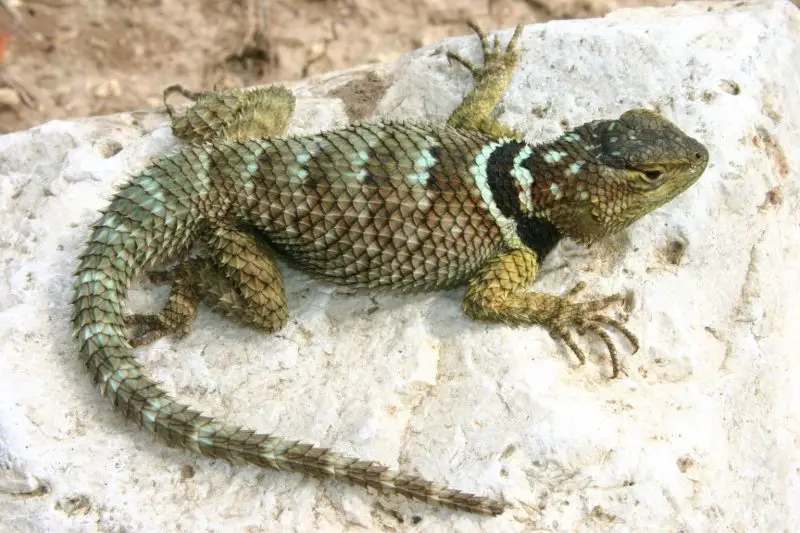
The Texas Spiny Lizard is a large, robust species ranging from Texas into parts of Georgia and neighboring states. It typically measures 7 to 9 inches in length and is notable for its rough, spiny scales and olive to brown coloration with dark blotches. Males exhibit bright blue patches on the belly and throat during the breeding season.
This lizard is commonly found in rocky, wooded areas and is an excellent climber, often spotted on tree trunks and large rocks. Its diet includes a variety of insects, spiders, and occasionally small vertebrates. Behaviorally, it is territorial and uses visual displays such as head bobbing and push-ups.
An interesting fact about the Texas Spiny Lizard is its adaptability to diverse habitats, from dry rocky hillsides to wooded forests. In Georgia, it occupies the westernmost areas, showcasing its wide environmental tolerance.
Carolina anole (Anolis carolinensis)

The Carolina anole is a small to medium-sized lizard native to the southeastern United States, including Georgia. Typically measuring around 5 to 8 inches in total length, this species is easily recognized by its bright green coloration, although it can change to brown depending on mood, temperature, or surroundings. Males often display a vibrant pink or reddish dewlap (throat fan) used for territorial displays and mating.
These anoles are agile climbers and spend much of their time in trees, shrubs, and on building walls. They primarily feed on insects such as crickets, flies, and beetles, contributing to natural pest control. The Carolina anole is known for its territorial behavior, with males actively defending their space from rivals through head-bobbing and push-ups.
A fun fact about Anolis carolinensis is its remarkable ability to regenerate its tail if lost to predators. This adaptation is crucial for survival in the wild. The species thrives in warm, humid environments and is commonly found in suburban yards, forests, and parks throughout Georgia.
Brown anole (Anolis sagrei)
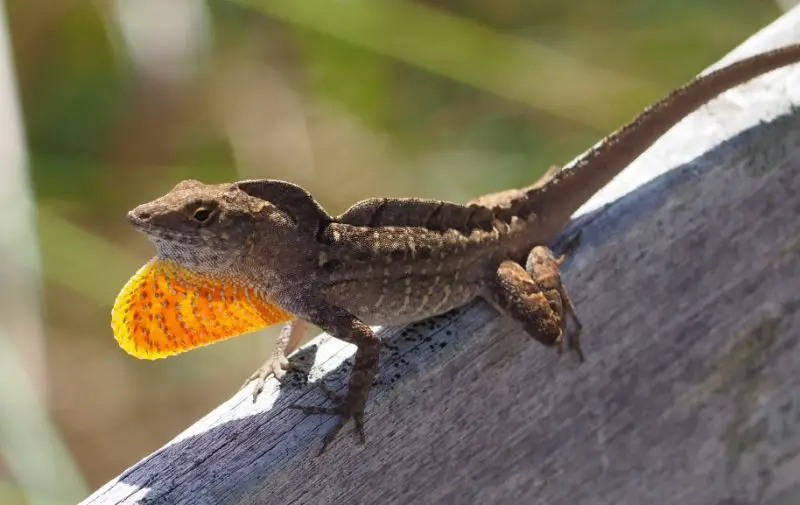
The Brown anole is a small, invasive lizard originally from Cuba and the Bahamas but now widespread in Georgia. It typically measures 5 to 7 inches in length and is easily identified by its brown or grayish body with darker markings and a distinctive orange or yellowish dewlap. Unlike the Carolina anole, it cannot turn green but exhibits a range of browns and grays.
Brown anoles are terrestrial and arboreal, often found on the ground, low bushes, and tree trunks. They are very aggressive and territorial, often displacing native lizard species like the Carolina anole. Their diet mainly consists of small insects and spiders.
One interesting fact about the Brown anole is its invasive nature; it has spread rapidly in the southeastern U.S. and significantly impacts local ecosystems. In Georgia, this species adapts well to urban and suburban environments, thriving in gardens, parks, and disturbed habitats.
Broad-headed Skink (Plestiodon laticeps)
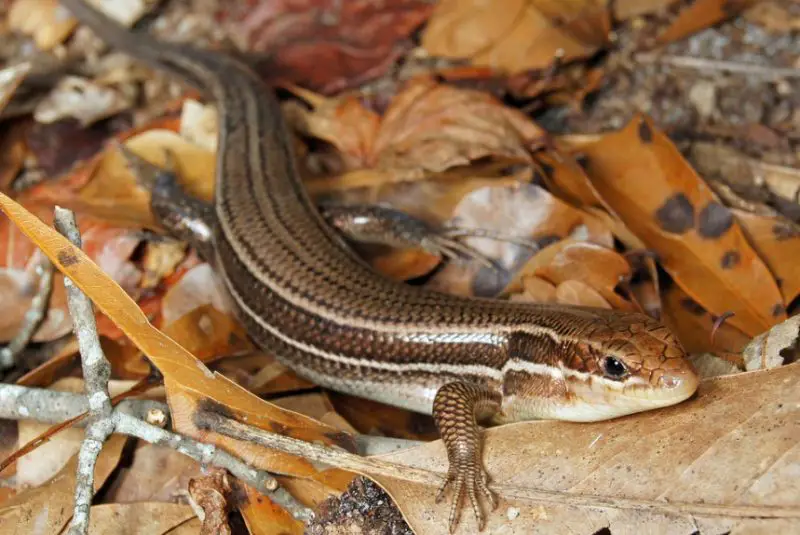
The Broad-headed Skink is one of the largest skink species found in Georgia, reaching lengths of up to 14 inches including the tail. Males are especially notable for their broad, triangular heads that become bright reddish-orange during the breeding season. Their bodies are sleek with shiny scales, generally brown or olive with faint stripes.
These skinks are excellent climbers and are often found in wooded areas, particularly near water sources. They are primarily insectivores, feeding on a variety of insects, spiders, and small invertebrates. Broad-headed skinks are known for their active and fast movements, often darting quickly to escape predators.
A fascinating fact about Plestiodon laticeps is that the bright coloration of the males during mating season signals dominance and attracts females. This species also has the ability to drop and regrow its tail as a defense mechanism.
Five-lined Skink (Plestiodon fasciatus)
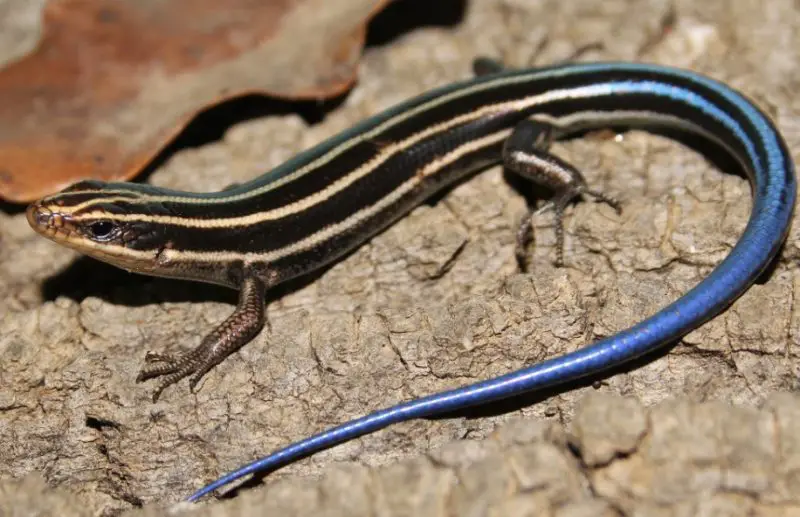
The Five-lined Skink is a common and widespread lizard in Georgia, measuring around 6 to 8 inches in length. Juveniles are easily identified by their striking black bodies with five bright white or yellow stripes running from head to tail, and their vivid blue tails. Adults become more brownish with age but retain the stripes and tail color to some extent.
This species prefers moist, wooded habitats with plenty of leaf litter and fallen logs, which provide shelter and hunting grounds. Their diet mainly consists of insects and other small arthropods. They are active during the day and use quick bursts of speed to catch prey or evade threats.
An interesting behavior of Plestiodon fasciatus is the use of its bright blue tail to distract predators; if attacked, the tail can detach, allowing the skink to escape while the predator focuses on the wriggling tail.
Southeastern Five-lined Skink (Plestiodon inexpectatus)
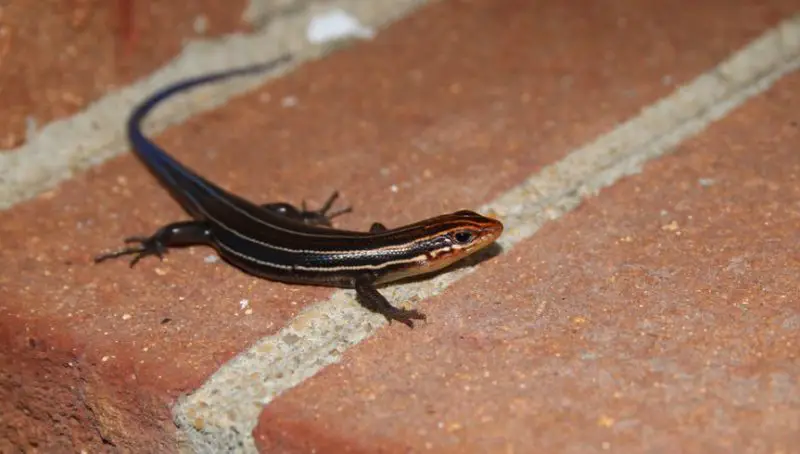
The Southeastern Five-lined Skink is very similar in appearance to the Five-lined Skink but is generally found in the southeastern parts of Georgia and neighboring states. It grows up to 7 to 8 inches long and shows the characteristic five light stripes on a darker background, with juveniles having bright blue tails.
This skink inhabits pine forests, sandy woodlands, and areas with loose soil suitable for burrowing. It feeds mainly on insects such as beetles, ants, and spiders. These lizards are often seen basking on logs or rocks and are highly territorial.
A fun fact about Plestiodon inexpectatus is that despite its close resemblance to other five-lined skinks, it was only recognized as a distinct species relatively recently, highlighting the diversity of skinks in the southeastern U.S.
Florida Five-lined Skink (Plestiodon egregius)
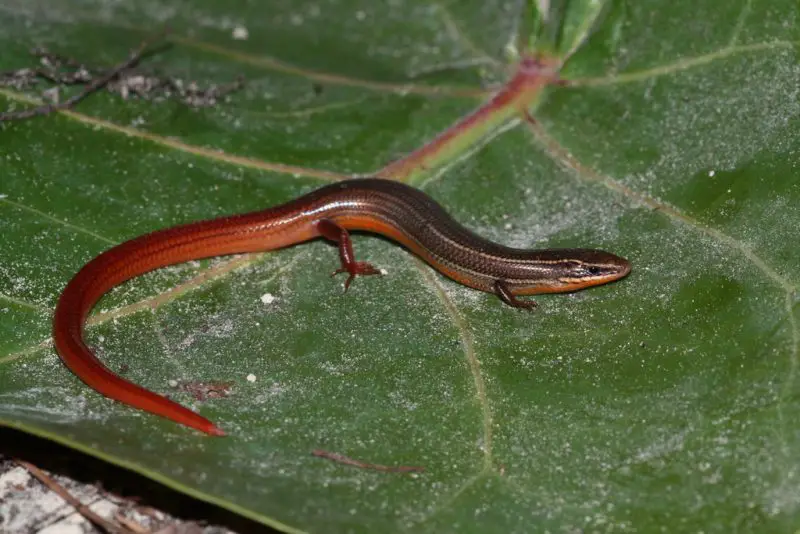
The Florida Five-lined Skink is a smaller, more elusive skink species that prefers scrub and sandhill habitats, including parts of southern Georgia. It measures about 4 to 6 inches in length and features five light stripes running down its body, with juveniles displaying vivid blue tails that fade with age.
This skink is primarily insectivorous, feeding on small insects and other arthropods found in leaf litter and sandy soils. It is secretive and less frequently observed than other skinks, often hiding under logs or vegetation to avoid predators.
An interesting fact about Plestiodon egregius is its preference for very specific sandy habitats, making it sensitive to environmental changes and habitat destruction, which affects its distribution and population.
Six-lined Racerunner (Cnemidophorus sexlineatus)
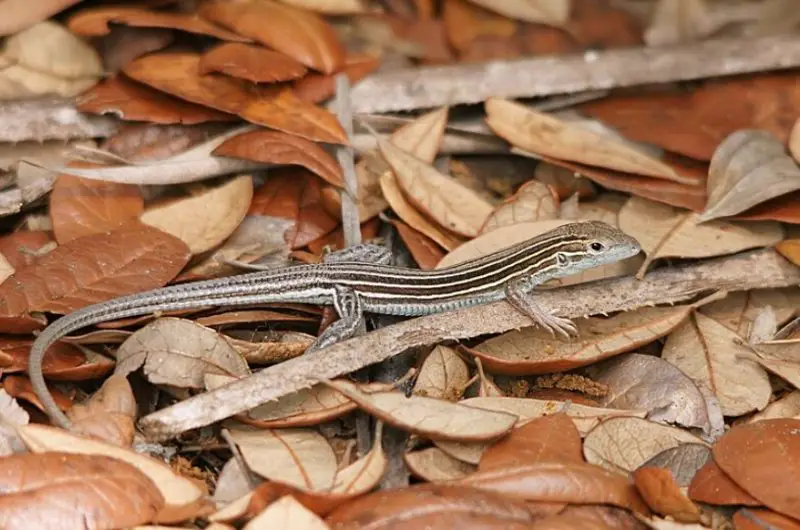
The Six-lined Racerunner is a fast-moving, slender lizard known for its speed and agility. Measuring around 6 to 9 inches long, it has six distinctive light stripes running down its dark brown or black body. Its long tail aids in balance during rapid movements.
This species favors open, sunny habitats such as sandy fields, pine barrens, and scrublands where it can sprint after prey. It feeds primarily on insects and other small invertebrates. Racerunners are diurnal and extremely active, often seen darting across the ground.
A fun fact about the Six-lined Racerunner is that it can run on its hind legs for short distances, an unusual trait among lizards that helps it quickly escape predators in Georgia’s open habitats.
Western Whiptai (Cnemidophorus tigris)

The Western Whiptail is a slender, fast-moving lizard commonly found in arid and semi-arid regions, though its range extends into parts of the southwestern United States. It measures about 8 to 12 inches in length, including a long, whip-like tail that often exceeds the body length. Its body coloration is typically gray or brown with darker tiger-like stripes running longitudinally, giving it its name.
This species thrives in rocky, open habitats such as deserts, grasslands, and scrublands where it actively hunts for insects, spiders, and other small invertebrates. Known for its incredible speed, the Western Whiptail uses rapid bursts of running to capture prey and evade predators.
A notable fact about Cnemidophorus tigris is its parthenogenetic reproduction in some populations—females can reproduce without males, producing genetically identical offspring. This rare reproductive strategy is an interesting aspect of their biology.
Tropical Racerunner (Cnemidophorus lemniscatus)
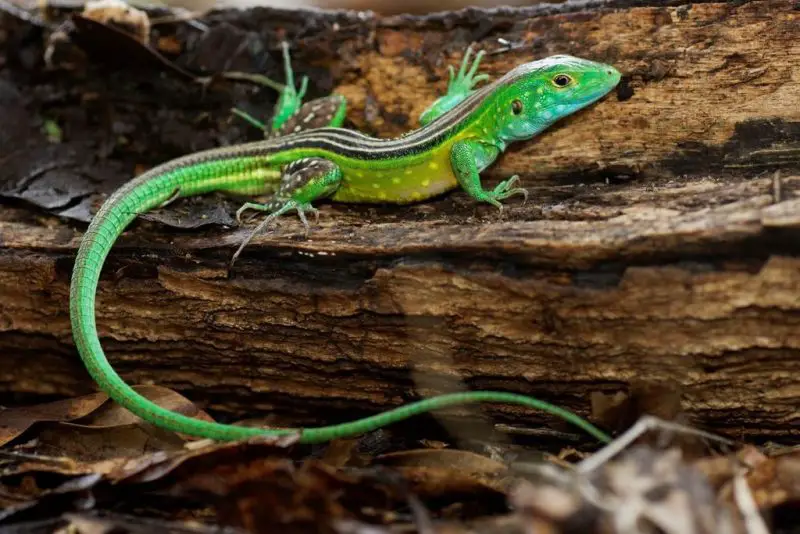
The Tropical Racerunner is a slender, agile lizard native to Central and South America but occasionally found in southern regions close to Georgia. It measures around 7 to 9 inches long and is marked with bright stripes or bands along its body, which can vary in color from light yellow to white on a darker background.
Preferring warm, open habitats like savannas and forest edges, this species actively hunts insects and other small arthropods. It is diurnal and highly energetic, often seen sprinting across the ground in pursuit of prey or to escape threats.
An interesting feature of the Tropical Racerunner is its adaptability to a wide range of tropical and subtropical habitats, allowing it to thrive in both disturbed and natural environments.
Coal Skink (Eumeces anthracinus)

The Coal Skink is a relatively small skink found in the southeastern U.S., including Georgia. It typically measures 5 to 7 inches in length and has smooth, shiny scales with a dark, almost black body marked by two light stripes running down its back. Its underbelly is usually pale, contrasting with the darker upper body.
Coal Skinks inhabit moist, wooded environments near streams, logs, and rocky outcrops. They are insectivorous, feeding on small insects, spiders, and other arthropods. They are secretive and quick, often hiding under debris or rocks when disturbed.
A fun fact about Eumeces anthracinus is its ability to squeeze into very narrow crevices to escape predators, aided by its flattened body shape and smooth scales.
Broad-headed Skink (Eumeces laticeps)
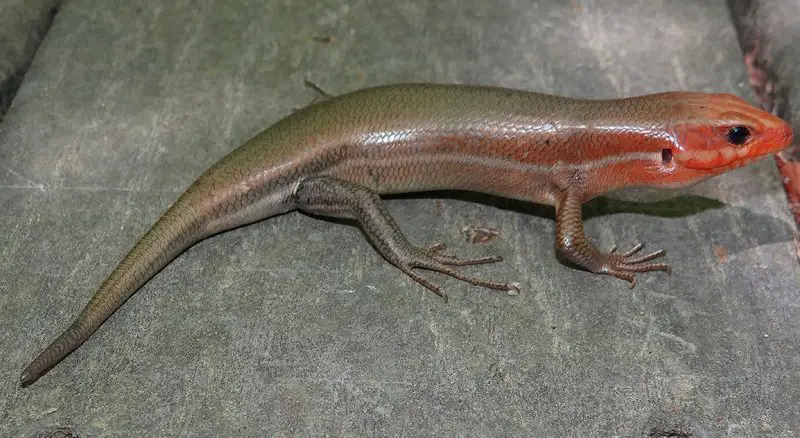
The Broad-headed Skink is one of the largest skinks in the southeastern U.S., reaching lengths up to 14 inches including the tail. Males are particularly notable for their broad, triangular heads which turn bright orange or red during the breeding season, while females and juveniles have more subdued brown or olive coloring with faint stripes.
This species prefers mature forests with abundant trees and logs, where it can climb and forage for insects, spiders, and occasionally small vertebrates. It is an active and territorial lizard, with males displaying aggressive behaviors to defend their territory.
A fascinating fact about the Broad-headed Skink is its vibrant breeding colors and complex social behavior, including males performing push-up displays to assert dominance during mating season.
Prairie Skink (Eumeces obsoletus)

The Prairie Skink is a small to medium-sized skink native to the central United States, sometimes found in the western parts of Georgia. It grows to about 5 to 7 inches in total length and features a slender body with smooth scales. Its coloration is generally brown or tan with faint, darker stripes running down the back.
Prairie Skinks prefer open grasslands, prairies, and sandy areas where they forage for insects and other small invertebrates. They are ground-dwelling and rely on speed and camouflage to avoid predators. These skinks are most active during warm daylight hours.
An interesting fact about Eumeces obsoletus is its adaptation to open habitats, which contrasts with many other skink species that prefer wooded or moist environments. This makes it an important part of prairie ecosystems.
Five-lined Skink (Plestiodon fasciatus)
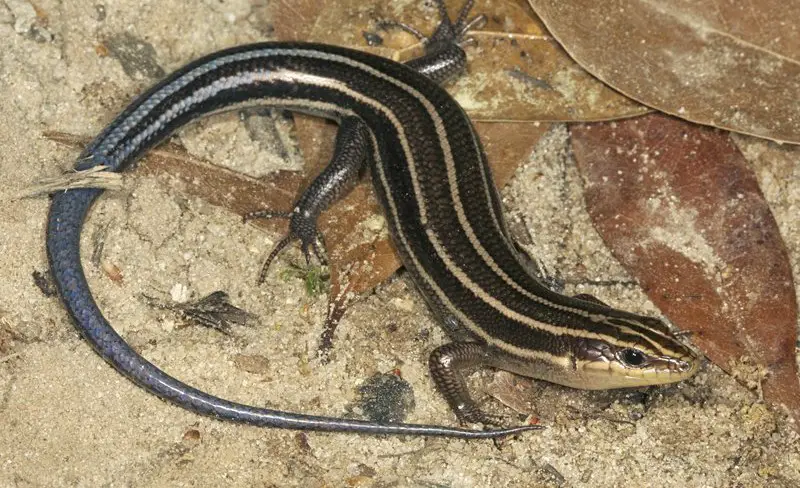
The Five-lined Skink is one of the most recognizable skinks in Georgia, measuring about 6 to 8 inches in total length. Juveniles are marked by five bright white or yellow stripes running down a black or dark brown body, with vibrant blue tails that fade with age. Adults tend to be browner but retain the characteristic stripes.
This species prefers moist, wooded habitats with plenty of ground cover such as logs and leaf litter. It is an insectivore, feeding on a variety of small insects and arthropods. The Five-lined Skink is known for its quick movements and ability to shed its tail as a defense mechanism.
An interesting behavior of this species is the use of its blue tail to distract predators, which can detach if grabbed, allowing the skink to escape while the tail continues to wiggle.
Gilbert’s Skink (Eumeces gilberti)
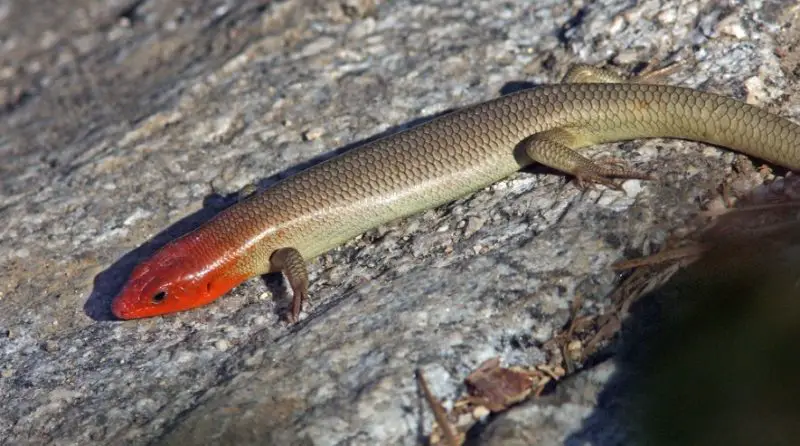
Gilbert’s Skink is a lesser-known medium-sized lizard found in parts of the southeastern United States, including Georgia. It measures around 6 to 7 inches in length and is characterized by a more uniform brown or olive coloration, with less distinct striping compared to other skinks in the region.
This skink inhabits wooded areas and forest edges, often hiding beneath bark, logs, or leaf litter. Its diet consists primarily of insects and other small invertebrates. Gilbert’s Skink is secretive and tends to avoid open areas, relying on camouflage for protection.
A notable fact about Eumeces gilberti is that it was only relatively recently distinguished as a separate species, highlighting the complexity of skink diversity in the southeastern U.S.
Southern Glass Lizard (Ophisaurus ventralis)
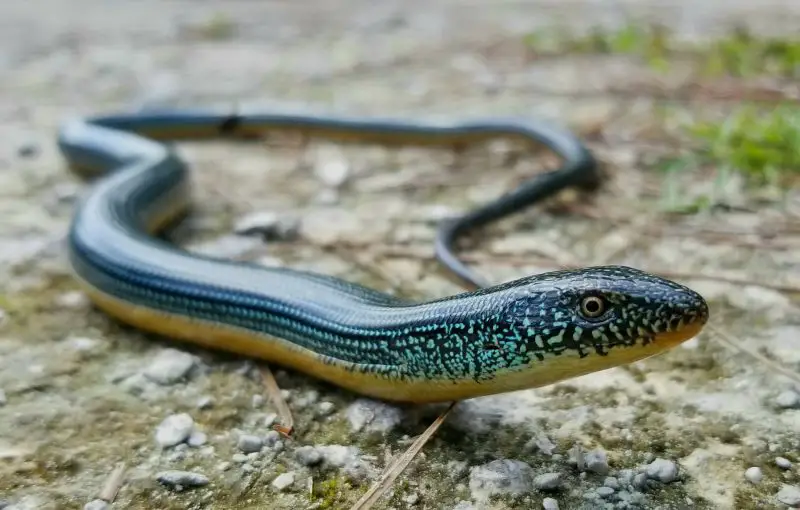
The Southern Glass Lizard is a legless lizard native to the southeastern United States, including Georgia. Measuring between 18 to 24 inches long, it resembles a snake but can be distinguished by its movable eyelids and external ear openings. Its body is slender with smooth scales, usually tan or light brown with faint darker stripes running along the sides.
This species prefers open habitats such as pine flatwoods, sandy fields, and grassy areas where it hunts for insects, spiders, and small vertebrates like baby mice. Despite its snake-like appearance, the Southern Glass Lizard moves with a distinctive wriggling motion typical of legless lizards.
A fun fact about Ophisaurus ventralis is its ability to autotomize, or break off, its tail when threatened. The tail can break into several pieces, distracting predators, and will regenerate over time, which is why it’s called a “glass” lizard.
Mediterranean House Gecko (Hemidactylus turcicus)
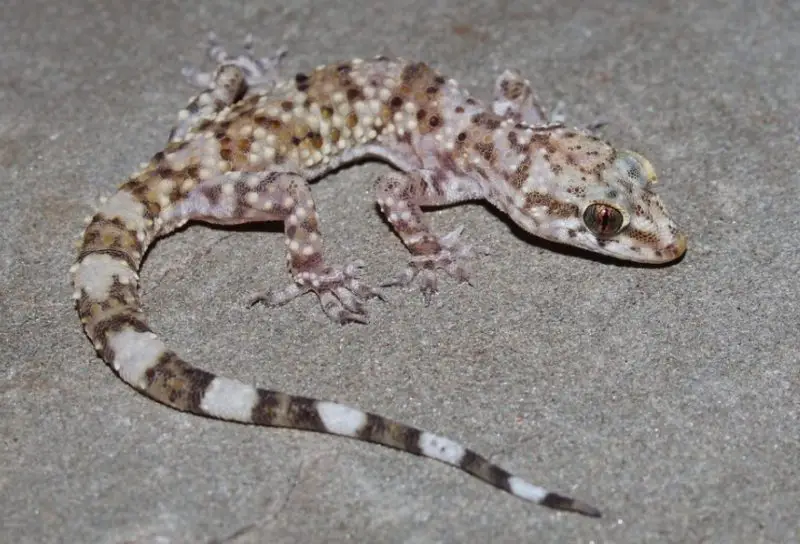
The Mediterranean House Gecko is a small, nocturnal gecko species introduced to the southeastern United States, including Georgia. It measures about 3 to 5 inches in length and has a somewhat translucent, grayish to light brown body covered with tiny tubercles (bumps). Its large eyes have vertical pupils, aiding its night vision.
This gecko is commonly found around human dwellings, especially on walls and ceilings where it hunts for insects attracted by lights. It feeds on moths, flies, and other small arthropods. The Mediterranean House Gecko is known for its distinctive, repetitive clicking calls heard during the night.
An interesting fact about Hemidactylus turcicus is its remarkable ability to climb smooth surfaces using specialized toe pads, allowing it to scale walls and even glass effortlessly. This adaptability has helped it thrive in urban environments.
FAQs about Lizards in Georgia
What types of lizards can be found in Georgia?
Georgia is home to a variety of lizard species, including anoles like the Carolina Anole and Brown Anole, skinks such as the Five-lined Skink and Broad-headed Skink, fence lizards like the Eastern Fence Lizard, and legless lizards such as the Southern Glass Lizard. These species inhabit diverse environments ranging from forests and scrublands to urban areas.
Are any lizards in Georgia venomous or dangerous to humans?
No, the lizards found in Georgia are not venomous and generally pose no threat to humans. They are shy creatures that typically avoid contact and help control insect populations. Bites are rare and usually occur only if the lizard is handled roughly.
How can I identify the Carolina Anole?
The Carolina Anole is a small lizard measuring about 5 to 8 inches long, notable for its bright green color that can change to brown. Males have a pink or reddish dewlap (throat fan) used for communication. They are commonly found on trees, shrubs, and walls in warm environments.
What do lizards in Georgia typically eat?
Most lizards in Georgia are insectivores, feeding on a variety of insects like crickets, flies, beetles, spiders, and other small arthropods. Some larger skinks may occasionally eat small vertebrates. Their diet helps keep pest populations in check.
Can lizards in Georgia regenerate lost tails?
Yes, many lizard species in Georgia, such as anoles and skinks, can autotomize (drop) their tails when threatened by predators. The tail can later regenerate, although it may not look exactly like the original. This defense mechanism helps them escape danger.
Where do lizards in Georgia prefer to live?
Lizards in Georgia occupy a range of habitats, including forests, pine flatwoods, scrublands, grassy fields, and urban areas like gardens and parks. Some species prefer moist environments near water, while others thrive in dry, sandy soils or rocky areas.
How can I attract lizards to my garden in Georgia?
To attract lizards, create a habitat with plenty of sunning spots like rocks and logs, provide shelter with dense shrubs or leaf litter, and avoid pesticides that reduce their insect food sources. A garden with diverse plants and natural hiding places is ideal for local lizard species.
Are legless lizards in Georgia snakes?
No, legless lizards such as the Southern Glass Lizard resemble snakes but differ by having eyelids, external ear openings, and a longer, more rigid body. These features help distinguish them from snakes despite their similar appearance.
What is the difference between the Brown Anole and the Carolina Anole?
The Brown Anole is an invasive species originally from the Caribbean and cannot change color to green; it has a brown or gray body with darker markings and an orange or yellowish dewlap. The native Carolina Anole is bright green (can turn brown) with a pink or red dewlap. Brown Anoles are more aggressive and often outcompete Carolina Anoles in some areas.
How do lizards in Georgia survive cold winters?
Many lizards in Georgia brumate, a hibernation-like state during cold months, by burrowing underground or hiding under logs and leaf litter to avoid freezing temperatures. Their activity slows significantly until warmer weather returns.


